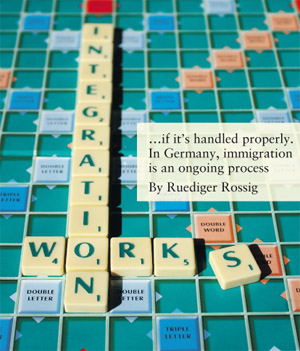Rüdiger Rossig | Journalist | Novinar
Integration works

Thilo Sarrazin has touched off a hot debate in Germany. In his book, “Deutschland schafft sich ab” (Germany does itself in), published at the end of August, the 65-year-old political economist claims that intelligence is hereditary. But Sarrazin doesn’t stop there.
He continues by suggesting that people from Muslim countries are less intelligent than Eastern European Jews, Asians or Germans, and that is why the integration of Muslim immigrants in Germany has failed. His conclusion: Because Muslims outbreed Germans, the population is slowly but surely becoming dumber.
Sarrazin’s recourse to eugenics, the genetics pseudo-science of the early 20th century, prompted harsh criticism in the media. In the Frankfurter Allgemeine Sonntagszeitung newspaper, Frank Schirrmacher warned against “biologistic folly.” Other authors reminded readers that the Nazis’ obsession with race was also fueled by eugenics.
One reason the book has caused such a stir is the prominence of its author. Over the past 35 years, Sarrazin has worked in a number of German ministries as well as for rail operator Deutsche Bahn. He was the city-state of Berlin’s finance minister before becoming a board member of the Federal Republic’s Central Bank (Bundesbank).
The debate became shriller. Defending his book in an interview with the conservative daily, Die Welt, Sarrazin said that “all Jews share a certain gene,” and cited an article in the current issue of “nature” magazine. In fact, the article talked about the frequent occurrence of a gene in certain Jewish communities and said nothing about one gene that all Jews have in common.
The chairman of the Central Council of Jews in Germany, Stephan J. Kramer, called the comment racist and added that Sarrazin was speaking to the same “basest human instinct” that had prompted the Nazis to persecute and murder Jews. Sarrazin quickly made an about-face, admitting that his statements were “a lot of nonsense” and that he had had a “blackout.”
But it was too late for Sarrazin. Chancellor Angela Merkel (CDU) let it be known that she expected a “reaction” from the Bundesbank, pointing out that the bank’s board members “were representatives of Germany.” Foreign Minister Guido Westerwelle (FDP) and Defense Minister Karl-Theodor zu Guttenberg (CSU) agreed, as did the opposition The Left party and the Greens. And members of the SPD started calling for Sarrazin’s expulsion from their party.
Confronted by this storm of protest, Sarrazin resigned from his position on the Bundesbank board, observing that nobody could hold out against the “entire political establishment and 70 percent of popular opinion.” And the curtain came down on the first act of the “Sarrazin Affair.”
Meanwhile, opinion polls, letters to the editor, the online reader’s forums of major German media outlets and the sold-out book tour appearances showed that many Germans agree with Sarrazin’s criticism of immigration – not with his theories, but with some deplorable facts he cites.
In Germany, as in the US and many other Western countries, there is a widespread fear of political Islamism and “over-foreignization.” Sarrazin had already fanned the flames of those fears a year earlier, when he told Lettre International magazine that Turks were conquering Germany with the same weapon that the Albanians were using to take over Kosovo: a high birthrate. He added that economically, Muslims have cost a lot more than they have contributed.
But has Germany really failed to integrate the four million immigrants from Muslim countries living here? Let’s look at some facts.
First of all, Muslims are the second-largest religious community in Germany after Christians. But less than 10 percent of immigrants from Muslim countries regularly worship in mosques. And the federal interior minister has taken an interest in the integration of Muslim believers since 2006 – as part of the German Islam Conference (DIK).
Most of the immigrants from mainly Islamic countries are Turks, Kurds, Bosnians, Kosovo Albanians, Palestinians, Lebanese, Iraqis and Iranians who are looking for a better life in Western Europe. Many of them tend toward the political left wing, and the absolute majority is not actively religious. The share of these secular immigrants has been steadily growing for years.
Another factor to consider is that the socio-economic structure of the Muslim community in Germany has changed a lot in the past few years. Although the first Muslim immigrants were mainly unskilled – and therefore cheap – laborers, there are now increasingly more skilled, professionally successful immigrants from Islamic countries.
In the past 10 years, more than one million foreigners have become German citizens. Well-integrated immigrants in particular are more likely to take this step. Because these new Germans no longer appear in the statistics on foreigners, immigrants who do not have German passports are always poorly integrated by definition.
The problem districts of German cities are not only inhabited by Muslims. Many “late emigrants” came from the former Soviet Union whose families were originally German. Many thousands of Vietnamese who came to former East Germany as “contract workers” in the 1980s live in the Hohenschönhausen district of Berlin, for example.
The fact that many native Germans perceive immigration as a problem is the result of the mistaken assumption that the guest-workers recruited since 1955 would return home at some point. The alternative false assumption was fostered by left-wing Social Democrats and Greens. Tolerance for foreign cultures turned into willful ignorance when confronted with the challenges posed by immigration. For many years, these groups pushed the argument that there should be no “forced Germanization.”
Integration of immigrants is a problem in many countries, but it can be successfully managed. Actually, it succeeded in the case of half a million Poles who lived in Germany’s Ruhr Valley before World War I. About 13 percent of the areas residents were Poles. Many people thought the “Polacks” could never be integrated. Today, many families in Cologne and Recklinghausen have Polish last names – and no one would dream of calling them immigrants or foreigners.
Immigration is working. A long list of immigrants with successful careers is proof: Soccer player Mesut Özil, Green party co-chairman Cem Özdemir, CDU regional Social Affairs Minister Aygül Özkan, film director Fatih Akin, author Feridun Zaimoglu and tourism entrepreneur Vural Öger, are some examples.
Not in the limelight, but also as important is 33-year-old Osman Ifsen. Amid the Sarrazin-debate, the child of Turkish immigrants who was educated in the German school system, became the first associate professor in Germany to hail from the classic “guest worker” background.
The increasing share of high school graduates among immigrant children is an indication that integration is working. Today, 18 percent of children of Turkish descent qualify to go to college. While almost 70 percent of first generation immigrants had no job qualifications, today that share has dropped to 28 percent.
That is why Interior Minister Thomas de Maizière (CDU) supports the development of pre-school opportunities for the children of new immigrants in addition to a language program for their parents. To achieve this, Germany needs many more teachers with an immigration background.
Regarding such initiatives, Sarrazin failed, according to Heinz Buschkowsky, mayor of Berlin’s predominantly immigrant Neukölln district. “Sarrazin is acting as if he had never been a politician,” he said. When he was Berlin’s finance minister, Sarrazin cut funding for the pre-school classes that prepare the educationally disadvantaged children of immigrants for school – in Neukölln of all places. These classes are recognized as being the best and most cost-efficient instruments of integration but that did not stop Sarrazin.
Kirsten Heisig, the late Berlin juvenile court judge, took the opposite tack. In her book, “Das Ende der Geduld. Konsequent gegen jugendliche Straftäter” (The end of patience – dealing firmly with young criminals), she does not make blanket statements against specific ethnic groups, cultures or religions. Instead, Heisig uses a case-by-case, solution-oriented argument to explain how Germany can avoid splitting apart into “rich and poor, left-wing and right-wing, and Muslim and non-Muslim.”
The nine scientists whose interdisciplinary work led to the “Jahresgutachten Einwanderungsgesellschaft 2010” (Immigration Society Annual Report 2010) are also worth mentioning. The title is not spectacular but they interviewed 5,600 people – some with and some without an immigrant background – to arrive at their conclusion on integration: “guarded optimism.”
 The Africa Times
The Africa Times Deutsch
Deutsch  Naški
Naški  English
English 
